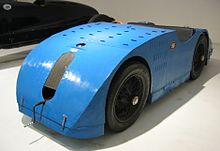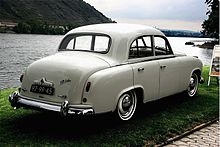Pontoon body
The pontoon body is a car body with smooth side parts, without attached fenders and running boards as a connection between the front and rear fenders.
The Bugatti Type 32 "Tank", which took part in the 1923 French Grand Prix in Tours, was one of the first known cars with a pontoon body .
The first production car in the world with a pontoon body was the Hanomag 2/10 PS (nickname "Kommissbrot") from 1925. At the end of the 1930s there were some pontoon bodies for the BMW 328 that were ahead of their time, but their further development and construction was done by the second World War were slowed down. Immediately after the end of the war, the Kaiser-Frazer and the Crosley CC with this shape came onto the market in the USA, and a little later in Europe the GAZ-M20 Pobeda (1946), Borgward Hansa (1949), the Fiat 1400 (1950) and the Ford Taunus 12M (1952). But already with the Renault Frégate (1950) the designers loosened the strict pontoon shape by suggesting rear fenders, as with the first Opel Olympia Rekord in 1953.
With the same external dimensions, the pontoon body has a wider interior space than the constructions of the time before the Second World War. In the 1950s to the early 1960s, almost all manufacturers switched to this shape with their new models. The last popular example of the "streamlined shape" of the late 1930s, apart from "exotic" vehicles such as Morgan Motor's sports car, was the VW Beetle , which was built up to 2003 alongside the modern VW models.
The pontoon shape was replaced by the trapezoidal line at the end of the 1950s, as in Italy with the Fiat 1800 , which replaced the 1900 , or in France with the Peugeot 404 , which followed the 403 .
The term pontoon body is no longer used for modern bodies , as there are hardly any completely smooth vehicle flanks - due to the bulging of the wheel cutouts or stabilizing beads . The term “pontoon body” generally only stands for the rounded, strongly arched forms in the automotive design of the 1950s, especially for the Mercedes-Benz 180 , which is called “Ponton-Mercedes” or “Ponton” for short.
Individual evidence
- ↑ Alfred Prokesch: Knaur's great book about the car . Droemer Knaur, Ascona 1980, ISBN 3-85886-089-1
- ^ Rob de la Rive Box: The Complete Encyclopedia of Vintage Cars 1886–1940 . Booksales Inc Remainders, 2006, ISBN 90-366-1517-8 , p. 147

